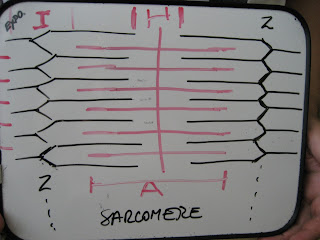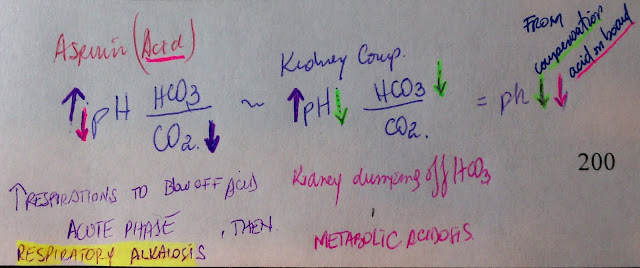Sunday, October 30, 2011
Monday, October 24, 2011
Cytocrome P450
INDUCERS
|
INHIBITORS
| |
Effect on drugs
|
Decreased (fail to respond)
|
Increased (risk of toxicity)
|
Anticonvulsivants
|
Barbiturates (Phenobarbital)
Phenytoin
Carbamazepine
Ethosuximide
|
Valproic Acid
|
Antibiotics
|
Rifampin
|
Chloramphenicol
Quinolones (Ciprofloxacin)
Macrolides (Erythromycin)
Sulfonamides (TMT SMX)
Isoniazid (INH)
|
Antifungals
|
Griseofulvin
|
Ketoconazole
Fluconazole
|
Alcohol
|
Chronic alcoholism
|
Acute alcoholism
|
Fruits/ Plants
|
St. John's Wort
|
Grapefruit
|
Antiarrythmics
|
Quinidine
| |
Sterols
|
Glucocorticois
| |
Antiulcerous
|
Cimetidine
Omeprazole
| |
Antivirals
|
Ritonavir (HIV protease inhs)
| |
Antitumoral
|
Cyclosporin
|
• Patient presents with ↓ pain and temperature sensation over the lateral aspects of both arms. | What is the lesion? | Syringomyelia. | |
• Penlight in patient’s right eye produces bilateral pupillary constriction. When moved to | What is the defect? | Atrophy of the left optic nerve. | |
the left eye, there is paradoxical dilatation. | |||
• Woman involved in a motor vehicle accident cannot turn her head to the left and has right shoulder droop. | What structure is damaged? | Right CN XI (runs through the jugular foramen with CN IX and X), innervating the sternocleidomastoid and trapezius muscles. | |
• Man presents with 1 wild, flailing arm. | Where is the lesion? | Contralateral subthalamic nucleus (hemiballismus). | |
• Patient with cortical lesion does not know that he has a disease. | Where is the lesion? | Right parietal lobe. | |
• Patient’s tongue protrudes toward the left side, and | Where is the lesion? | Left medulla, CN XII. | |
patient exhibits a right-sided spastic paralysis. | <> |
Wednesday, October 19, 2011
Monday, October 17, 2011
Some renal Findings
Multiple myeloma Ischemic tubular necrosis Acute pyelonephritis Hypersensitivity interstitial nephritis Papillary necrosis & Chronic interstitial nephritis Aminoglycoside toxicity Lead nephropathy Urate nephropathy Acute Tubular Necrosis (renal azotemia) | Eosinophilic casts (Bence-Jones prot), in tubular lumens Ischemic tubular necrosis WBC Casts Drug-induced interstitial nephritis NSAID-associated nephropathy Aminoglycoside toxicity Chronic tubulointerstitial nephritis Needle shaped monosodium urate crystals are seen in the interstitium and tubular lumens Heavy metal poisoning with lead or mercury (produces Fanconi Sd) |
Friday, October 14, 2011
Steve Jobs Inspiring speech

Steve Jobs - Do Great Work
Steve Jobs on Connecting the Dots, Love & Loss and Doing Great Work
Steve Jobs - Stanford University Commencement Speech Transcript
I am honored to be with you today at your commencement from one of the finest universities in the world. I never graduated from college. Truth be told, this is the closest I've ever gotten to a college graduation. Today I want to tell you three stories from my life. That's it. No big deal. Just three stories.The first story is about connecting the dots.
Basic ECG concepts...(Arrhythmias Big picture)
Here are some basic concepts about ECG, the most important one, the conduction system of the heart which helps us to understand why the arrhythmias of the heart are studied in that order.
Begining with everything related to the Sinus Node and Atrium, continuing with the AV node where the conduction is slowed down (blocks are study here also), and then everything regarding the ventricles. If you get the big picture of this ECG will become one of the easiest subjects to learn.....
In all these main places we will have rhythms and arrhythmias that conserve the normal heart rate, and others that are faster or slower depending the location where the impulse is initiatied,.
For example
The normal HR for the Sinus Node is between 60 and 100, So according to this HR if the patient has:
Normal HR (60-100): Sinus Rhythm
Faster HR (>100): Sinus Tachycardia
Wednesday, October 12, 2011
Thursday, October 06, 2011
Respiratory
| AIRWAY EXTRATHORACIC (Lips to Glotis) INTRATHORACIC (Glotis tothe alveoli) | Breath IN Narrows Expands | Breath OUT Expands Narrows |
•Stridor: narrowing in extrathoracic airway (when breath in - INSPIRATION)
Ex: small, jaw, macroglossia (hypothyroidism, Down Sd., storage Dzz), large tonsils, large tonsils, laryngeal webs, laryngeal warts, peritonsil abscess, retropharyngeal abscess, epiglotitis, crup, diphteria.. DO A NECK FILM
•Wheeze: narrowing in intrathoracic airway (when you breath out - EXPIRATION)
It will expected on Obstructive lung dzz ( Asthmatics ) DO A CXR
Never it's a good thing to find wheezing on inspiration → (Bronchospasm, or mass) → sign of more distress pt probably needs to be in ICU
•Rhonchi: air moving over mucus (Obstructive, Productive cough)
•Crackles: collapsed airways “popping”open (All restrictive will have it) (obstructives later on)
–Surfactant is missing
–Alveoli have been scarred down
*DRUGS THAT CAUSE CRACKLES (Pulmonary Fibrosis)BBAT Busulfan, Bleomycin, Amiodarone, Tocainide
* Which patient will more likely have crackles Strep pneumonia or pneumocystis
Bacteria → obstructive (airway)→ Fungus → restrictive (interstitium)
-Strep. pneumonia:bacteria, affects airway, obstrucvitve dzz, ronchi (air moving over mucus)
-Pneumocystis Jirovecchi (fungus), affects intertitium, restrictive dzz, crackles
Tuesday, October 04, 2011
Aspirin Intoxication
Aspirin poisoning will produce respiratory alkalosis initially then will produce metabolic acidosis.
Others producing Metabolic acidosis are:
| Increased anion Gap (MUD PILES) M- Methanol U- Uremia D- DKA P- Paraldehyde or phenformin I- Iron tablets or INH L- Lactic Acidosis E- Ethylene glycol S- Salicilates | Normal anion Gap Diarrhea Renal Tubular Acidosis (alkaline urine ph < 5.5) Hyperchloreima |
Monday, October 03, 2011
Insulin Release in Pancreatic β Cell

DO NOT GIVE THIAZIDES TO HYPERGLYCEMIC, HYPERLIPIDEMIC, & HYPERURICEMIC PATIENS
Remember that normally insulin will inhibit HSL (Hormone Sensitive Lipase) required for the breakdown of stored TG in adipose tissue. Since thiazides stop the production of ATP on the pancreatic β cell, preventing the realease of insulin required for keeping TG inside of adipose tissue, this drugs are not given to hyperlipidemic patients.
Remember that normally insulin will inhibit HSL (Hormone Sensitive Lipase) required for the breakdown of stored TG in adipose tissue. Since thiazides stop the production of ATP on the pancreatic β cell, preventing the realease of insulin required for keeping TG inside of adipose tissue, this drugs are not given to hyperlipidemic patients.
Subscribe to:
Posts (Atom)









